How to divide and transplant hosts to a new location in spring, summer and fall
As a rule, hosts can grow in one place for a long time. But something happened (maybe it's just time to plant and rejuvenate overgrown bushes), and you decided to transplant your queen of a shady garden to another place, right?
Well, then you will find out when to replant hosts, how to properly divide the plant into parts and plant the divisions in new places.
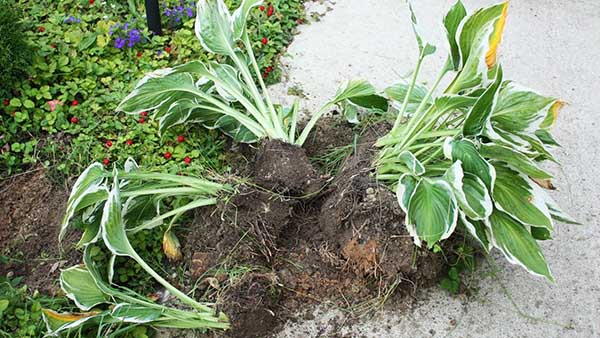
Content
- 1 Why share and transplant hosts
- 2 When is it better to replant hosts: in spring or autumn, is it possible in summer
- 3 How to transplant hosts: rules for preparing a new place
- 4 Step-by-step instructions for dividing and transplanting hosts in the fall to a new place
- 5 How to care for hosts after transplant
Why share and transplant hosts
Over time, the hosts grow very much, the sockets literally grow on top of each other, they become cramped. Because of this, the general decorativeness of the plant decreases: the color (bordering) begins to change, the leaves may become smaller.
In other words, old hosts are divided and seated in order to rejuvenate them.
It is believed that hosts can grow in one place for up to 10 years, but dividing and replanting can be done earlier. In this case, it is desirable that the host is over 5 years old.
When is it better to replant hosts: in spring or autumn, is it possible in summer
Hosts can be shared and replanted throughout the warm season. In other words, when it is convenient for you (there is time and desire), then you can transplant.
However, if you want the plant to be guaranteed to take root well in a new place, then it is best to do this in spring or autumn.
As for the approximate timing of the transfer, in the Central lane (Moscow region):
- in spring they are usually transplanted in late April-early May (i.e. before or at the beginning of the growing season),
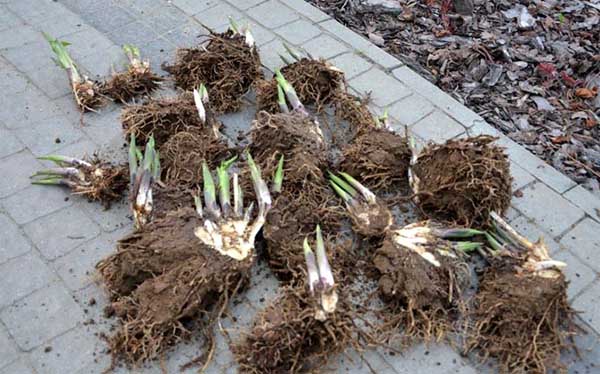
- and in autumn - at the end of August-September (one month before frost).
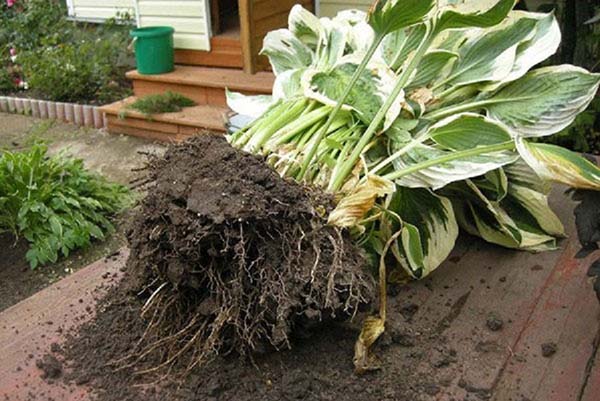
By the way! If you live in a region with a short summer, then a transplant in June is called rather a spring event, and in August it is already an autumn one.
In the middle of summer (in July), when it is hot and dry, it is not recommended to transplant and plant plants with an open root system (OKZ). However, it is quite acceptable under the condition of careful post-plant care, namely regular watering.
Still, it is believed that hosts it is better to replant in autumnrather than spring.
Why?
The fact is that in the spring both roots and leaves grow at the same time, and if the weather is hot, the plant will suffer. Whereas in the fall only roots grow in plants, which means that in the spring the roots that have taken root will be able to fully nourish the growing leaves.
How to transplant hosts: rules for preparing a new place
Place in the garden
As you know, the host is shade-tolerant and even in some sense shade-loving plant, in other words, you need to find sun-protected place in the garden, and it is desirable that it was exactly penumbra.
For example, it could be:
- north (northeast or west) side of the house or fence;
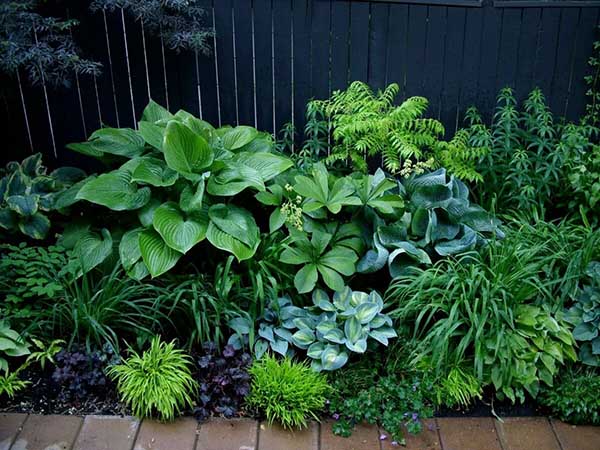
- the shade of the crown of tall trees or shrubs, in other words, can be planted directly in the trunk circle.
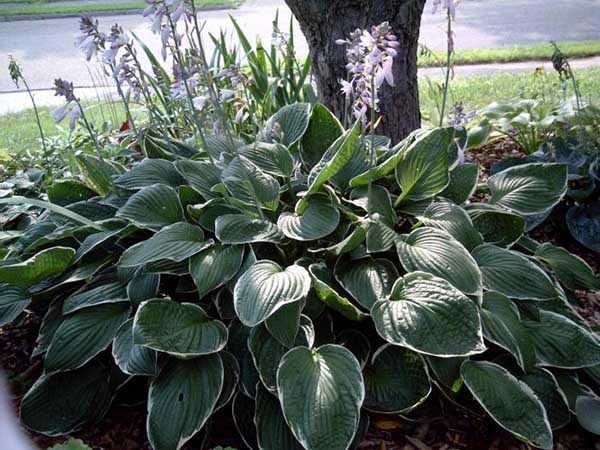
What is partial shade?
This is when the sun hits the selected area only in the first or second half of the day (4 hours or more). But for hosts better when the sun illuminates the plant exactly in the first half of the day.
Important!The place is considered shady (shadow)if it is illuminated by the sun during the day within 2-4 hours: either only in the morning - from sunrise to 8 am, or only in the evening - after 4 pm and until sunset.
However, it should be borne in mind that some host varieties (especially variegated = variegated) still love the sun and their decorative effect will be noticeably reduced with strong shading.
Note! As a rule, the darker the leaves of the hosta, the more shady the variety can be planted and vice versa.
For example, varieties with blue or blue leaves in the shade, with light or yellow leaves in the sun.
Preparing the soil
Hosta is a very unpretentious plant that can grow on any soil, even in clay.
But, of course, it is better to prepare a fertile area for the hosta by mixing humus or compost with the garden soil, as well as peat (you can even have a little sour peat, because the hosta likes a slightly acidic soil, neutral in acidity). If you have excess fertilizer for decorative deciduous plants, you can add it too.
Step-by-step instructions for dividing and transplanting hosts in the fall to a new place
- Prepare a new place (landing pit) for transplanting.
- Naturally, before dividing, the bush must be dug up.
By the way! If you just need to plant a piece from the old hosta, you don't have to dig out the whole bush, but cut off and dig out only a part.
If you just want to rejuvenate the bushes, then you need to dig up and divide, as will be described below.
- To dig up a bush, you need to carefully dig it from all sides.
- Get the bush together with the earthen lump and proceed to direct division.
- The easiest way is to simply take a shovel and split the bush in half.
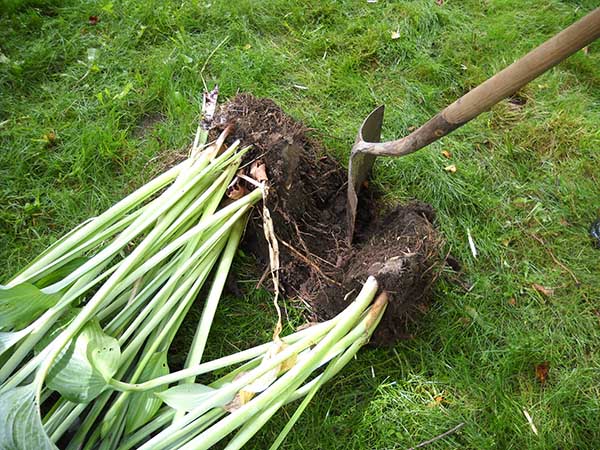
Advice! It is very convenient to initially divide the rhizomes (less traumatic for plants) using two garden forks. They need to be carefully, end-to-end, pressed into the center of the bush and gently spread in opposite directions.
- But if you want to get more planting material, then you can try (It will be difficult!) To divide it into a cut (rosette) with a knife: stick a knife between the rosettes and cut the roots. As a result, you should have a dividend on your hands (it is desirable that one division consists of two outlets and at least 2-4 leaves).
It is believed that when transplanting, it is advisable not to bare the roots (they must be in the ground!).
However! Many gardeners expose the roots on purpose. Namely, they spill the bushes with water or even soak them in a large basin, so that it is then convenient to separate the sockets (with your hands or with a knife) and you can get the maximum number of divisions (new seedlings).
Moreover, roots that are too long can be shortened.
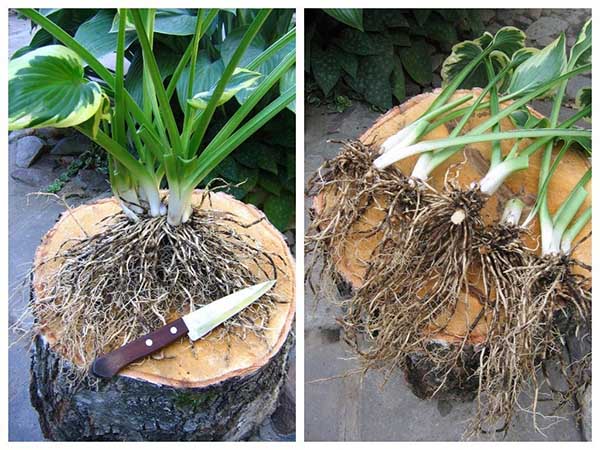
- Sprinkle the cuts with ash or rub with crushed coal (you can treat with brilliant green).
The cut is treated from decay (especially if you have heavy loam).
- That's it, now you can plant the received divisions in a new place.
- Place the seedlings in pre-prepared planting holes flush with the soil level, in other words, just as they grew (no need to deepen).
- Sprinkle with soil and compact.
- Water thoroughly and abundantly.
If the earth settles, then add it and spill it lightly with water again.
- In order for the hosts to take root better, you can optionally remove excess foliage (in any case, you will break some of the foliage) to reduce the evaporation area. As a rule, the lower leaves (which are closer to the ground) are removed.
However! In autumn, the hosts take root well after transplanting and with all the foliage. In general, the loss of leaves is also a significant stress for the plant.
- Mulch (with peat, sawdust) so that a crust does not form on the ground.
Video: reproduction of hosts by dividing the bush
Features of division in spring
In general, the process of dividing and transplanting hosts in the spring is completely similar, however, this must be done at the right time. Namely, when the hosts have only new leaves will begin to grow in the form of sharp cones.
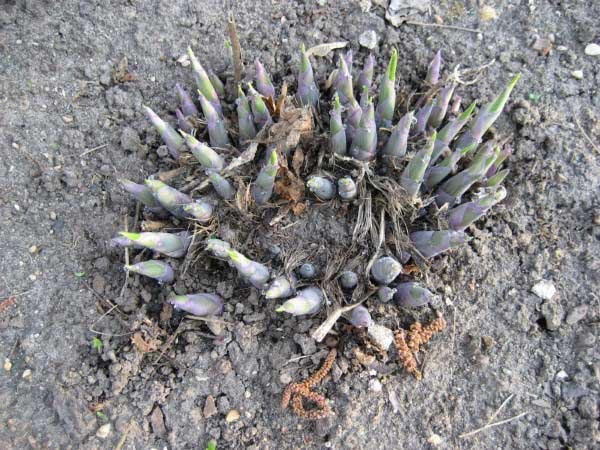
Video: transplantation and reproduction of hosts by division in spring
How to care for hosts after transplant
Once again, the hosta is a very unpretentious plant, which means that after planting a minimum of participation is required from you. You just need to water it (if the place is shady = wet, then very rarely, if sunny, then moderately).
By the way! The leaves of the plant cover the ground quite tightly, which means that no weeds can grow under the hosts, in other words, nothing will have to be weeded and loosened.
Nevertheless, some agrotechnical measures may be relevant to you:
- Top dressing (if there is an opportunity and desire). The scheme is standard: in the spring - nitrogen (to start the growth of greenery), in the summer - potassium and phosphorus (you can use wood ash) or just a complex mineral fertilizer (such as nitroammofoska).
- Pruning peduncles. Hosts tend to be grown for ornamental leaves rather than flowers. Therefore, it is recommended to cut off the peduncles in a timely manner (as soon as they begin to form).
- Pruning leaves... Everything is at your discretion. Of course, you can prune the leaves for the winter (after they dry out from the frost), but it is quite possible to leave. Then they themselves will disappear, and in the spring they will just need to be removed.
Advice! Other important points regarding autumn care and preparation of hosts for winter, you can read in this article.
- Diseases to pests... The host almost never gets sick and is not affected by any fungal diseases (perhaps viral, but very rarely), but she is often attacked by such arrogant pests as slugs... They really have to fight.
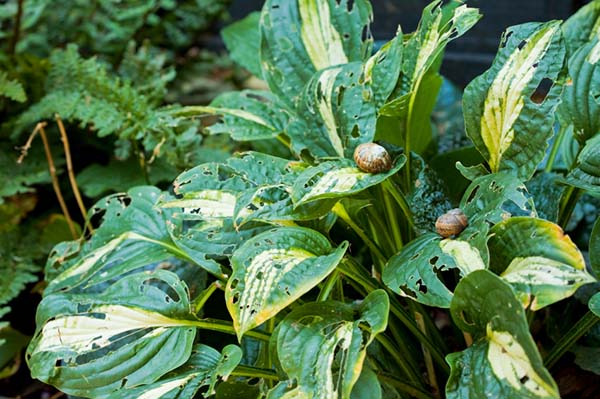
As you understand, dividing and replanting hosts is not so difficult, you just need to choose the right time, make a little effort when digging a bush, carefully and carefully divide it, and then plant it in a new place.
Opinions:
“I share it with the host without any problems, I just cut it with a shovel. She is very tenacious. "
"Hosta grows very quickly and you can seat at any time."
"Hosts are different: there are very capricious ones who do not grow so quickly and grow after division and transplantation".
Video: how to share and transplant a host in the fall

